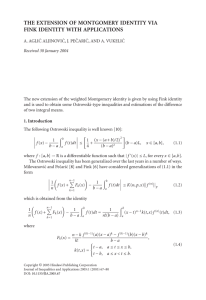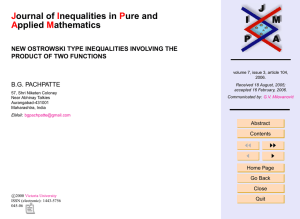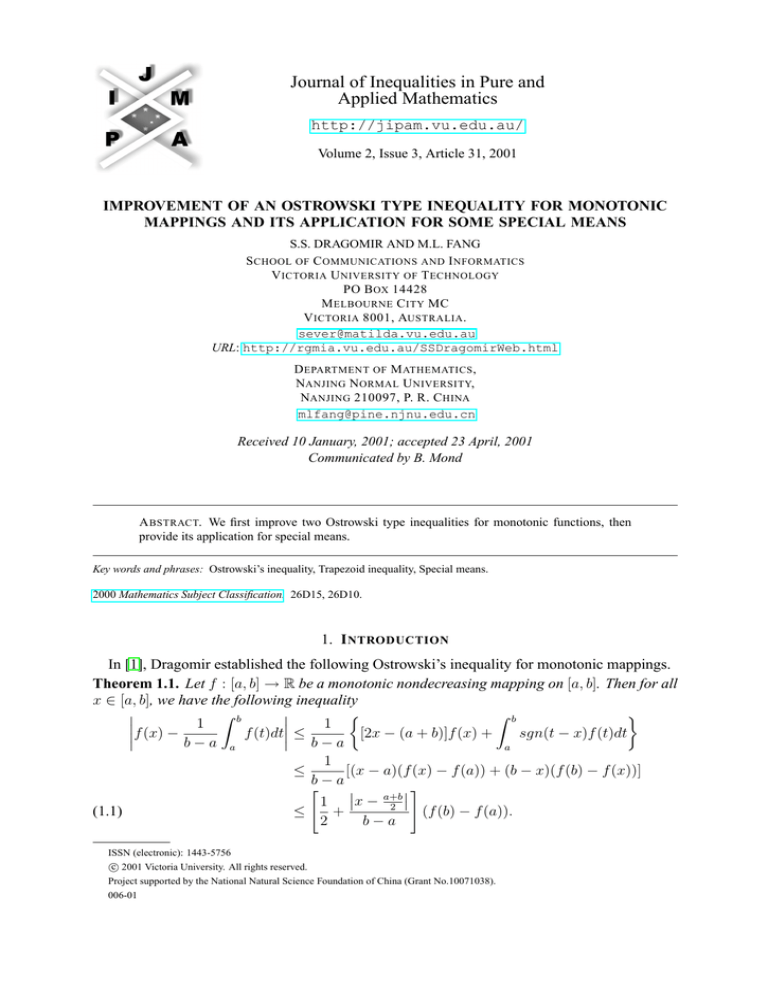
Journal of Inequalities in Pure and
Applied Mathematics
http://jipam.vu.edu.au/
Volume 2, Issue 3, Article 31, 2001
IMPROVEMENT OF AN OSTROWSKI TYPE INEQUALITY FOR MONOTONIC
MAPPINGS AND ITS APPLICATION FOR SOME SPECIAL MEANS
S.S. DRAGOMIR AND M.L. FANG
S CHOOL OF C OMMUNICATIONS AND I NFORMATICS
V ICTORIA U NIVERSITY OF T ECHNOLOGY
PO B OX 14428
M ELBOURNE C ITY MC
V ICTORIA 8001, AUSTRALIA .
sever@matilda.vu.edu.au
URL: http://rgmia.vu.edu.au/SSDragomirWeb.html
D EPARTMENT OF M ATHEMATICS ,
NANJING N ORMAL U NIVERSITY,
NANJING 210097, P. R. C HINA
mlfang@pine.njnu.edu.cn
Received 10 January, 2001; accepted 23 April, 2001
Communicated by B. Mond
A BSTRACT. We first improve two Ostrowski type inequalities for monotonic functions, then
provide its application for special means.
Key words and phrases: Ostrowski’s inequality, Trapezoid inequality, Special means.
2000 Mathematics Subject Classification. 26D15, 26D10.
1. I NTRODUCTION
In [1], Dragomir established the following Ostrowski’s inequality for monotonic mappings.
Theorem 1.1. Let f : [a, b] → R be a monotonic nondecreasing mapping on [a, b]. Then for all
x ∈ [a, b], we have the following inequality
Z b
Z b
1
1
f (x) −
f (t)dt ≤
[2x − (a + b)]f (x) +
sgn(t − x)f (t)dt
b−a
b−a
a
a
1
[(x − a)(f (x) − f (a)) + (b − x)(f (b) − f (x))]
"b − a #
1 x − a+b
2
≤
+
(f (b) − f (a)).
2
b−a
≤
(1.1)
ISSN (electronic): 1443-5756
c 2001 Victoria University. All rights reserved.
Project supported by the National Natural Science Foundation of China (Grant No.10071038).
006-01
2
S.S. D RAGOMIR AND M.L. FANG
The constant 21 is the best possible one.
In [2], Dragomir, Pečarić and Wang generalized Theorem 1.1 and proved
Theorem 1.2. Let f : [a, b] → R be a monotonic nondecreasing mapping on [a, b] and t1 , t2 ,
t3 ∈ (a, b) be such that t1 ≤ t2 ≤ t3 . Then
Z b
f (x)dx − [(t1 − a)f (a) + (t3 − t1 )f (t2 ) + (b − t3 )f (b)]
a
Z
≤ (b − t3 )f (b) + (2t2 − t1 − t3 )f (t2 ) − (t1 − a)f (a) +
b
T (x)f (x)dx
a
≤ (b − t3 )(f (b) − f (t3 )) + (t3 − t2 )(f (t3 ) − f (t2 ))
+ (t2 − t1 )(f (t2 ) − f (t1 )) + (t1 − a)(f (t1 ) − f (a))
≤ max{t1 − a, t2 − t1 , t3 − t2 , b − t3 }(f (b) − f (a)),
(1.2)
where T (x) = sgn(t1 − x), for x ∈ [a, t2 ], and T (x) = sgn(t3 − x), for x ∈ [t2 , b].
In the present paper, we firstly improve the above results, and then provide its application for
some special means.
2. M AIN R ESULT
We shall start with the following result.
Theorem 2.1. Let f : [a, b] → R be a monotonic nondecreasing mapping on [a, b] and let t1 ,
t2 , t3 ∈ [a, b] be such that t1 ≤ t2 ≤ t3 . Then
Z b
f (x)dx − [(t1 − a)f (a) + (t3 − t1 )f (t2 ) + (b − t3 )f (b)]
a
≤ max{(b − t3 )(f (b) − f (t3 )) + (t2 − t1 )(f (t2 ) − f (t1 )),
(t3 − t2 )(f (t3 ) − f (t2 )) + (t1 − a)(f (t1 ) − f (a))}
(2.1)
≤ max{t1 − a, t2 − t1 , t3 − t2 , b − t3 }(f (b) − f (a)).
(2.2)
Proof. Since f (x) is a monotonic nondecreasing mapping on [a, b], we have
Z b
f
(x)dx
−
[(t
−
a)f
(a)
+
(t
−
t
)f
(t
)
+
(b
−
t
)f
(b)]
1
3
1
2
3
a
Z t1
Z t3
Z b
= (f (x) − f (a))dx +
(f (x) − f (t2 ))dx +
(f (x) − f (b))dx
a
t1
t
Z t1
3
Z t3
(f (x) − f (t2 ))dx
= (f (x) − f (a))dx +
a
t2
Z
t2
−
Z
b
(f (t2 ) − f (x))dx +
t1
t3
(f (b) − f (x))dx ≤ max{(b − t3 )(f (b) − f (t3 )) + (t2 − t1 )(f (t2 ) − f (t1 )),
(t3 − t2 )(f (t3 ) − f (t2 )) + (t1 − a)(f (t1 ) − f (a))}
≤ max{t1 − a, t2 − t1 , t3 − t2 , b − t3 }(f (b) − f (a)).
Thus (2.1) and (2.2) is proved.
For t1 = t2 = t3 = x, Theorem 2.1 becomes the following corollary.
J. Inequal. Pure and Appl. Math., 2(3) Art. 31, 2001
http://jipam.vu.edu.au/
M ONOTONIC M APPINGS AND A PPLICATIONS
3
Corollary 2.2. Let f be defined as in Theorem 2.1. Then
Z b
f
(x)dx
−
[(x
−
a)f
(a)
+
(b
−
x)f
(b)]
a
≤ max{(b − x)(f (b) − f (x)), (x − a)(f (x) − f (a))}
≤ max{x − a, b − x} · max{(f (x) − f (a)), (f (b) − f (x))}
a + b 1
≤ (b − a) + x −
(f (b) − f (a)).
2
2 For x =
a+b
,
2
we get trapezoid inequality.
Corollary 2.3. Let f be defined as in Theorem 2.1. Then
Z b
f
(a)
+
f
(b)
f
(x)dx
−
(b
−
a)
2
a
b−a
a+b
a+b
(2.3)
max
f
− f (a) , f (b) − f
≤
2
2
2
1
≤ (b − a)(f (b) − f (a)).
2
For t1 = a, t2 = x, t3 = b, we get Theorem 1.1.
3. A PPLICATION
FOR
S PECIAL M EANS
In this section, we shall give application of Corollary 2.3. Let us recall the following means.
(1) The arithmetic mean:
A = A(a, b) :=
a+b
,
2
a, b ≥ 0.
(2) The geometric mean:
√
G = G(a, b) :=
ab,
a, b ≥ 0.
(3) The harmonic mean:
H = H(a, b) :=
2
,
1/a + 1/b
a, b ≥ 0.
(4) The logarithmic mean:
L = L(a, b) :=
b−a
,
ln b − ln a
a, b ≥ 0, a 6= b; If a = b, then L(a, b) = a.
(5) The identric mean:
1
I = I(a, b) :=
e
bb
aa
1
b−a
,
a, b ≥ 0, a 6= b; If a = b, then I(a, b) = a.
(6) The p-logarithmic mean:
p+1
1
b
− ap+1 p
Lp = Lp (a, b) :=
,
(p + 1)(b − a)
a 6= b; If a = b, then Lp (a, b) = a,
where p 6= −1, 0 and a, b > 0.
J. Inequal. Pure and Appl. Math., 2(3) Art. 31, 2001
http://jipam.vu.edu.au/
4
S.S. D RAGOMIR AND M.L. FANG
The following simple relationships are known in the literature
H ≤ G ≤ L ≤ I ≤ A.
We are going to use inequality (2.3) in the following equivalent version:
Z b
1
f
(a)
+
f
(b)
f (t)dt −
b − a
2
a
1
a+b
a+b
(3.1)
≤ max
f
− f (a) , f (b) − f
2
2
2
1
≤ (f (b) − f (a)),
2
where f : [a, b] → R is monotonic nondecreasing on [a, b].
3.1. Mapping f (x) = xp . Consider the mapping f : [a, b] ⊂ (0, ∞) → R, f (x) = xp , p > 0.
Then
Z b
1
f (t)dt = Lpp (a, b),
b−a a
f (a) + f (b)
= A(ap , bp ),
2
f (b) − f (a) = p(b − a)Lp−1
p−1 .
Then by (3.1), we get
(3.2)
p
p p
1
a
+
b
a
+
b
p
p
p
p
Lp (a, b) − A(a , b ) ≤ max
− a ,b −
2
2
2
p a+b
1 p
b −
=
2
2
p
1 p
1
a+b
p
p
= (b − a ) −
−a
2
2
2
1
p(b − a)ap−1
≤ p(b − a)Lp−1
−
.
p−1
2
4
Remark 3.1. The following result was proved in [2].
p
Lp (a, b) − A(ap , bp ) ≤ 1 p(b − a)Lp−1
p−1 .
2
3.2. Mapping f (x) = −1/x. Consider the mapping f : [a, b] ⊂ (0, ∞) → R, f (x) = − x1 .
Then
Z b
1
f (t)dt = −L−1 (a, b),
b−a a
f (a) + f (b)
A(a, b)
=− 2
,
2
G (a, b)
f (b) − f (a) =
J. Inequal. Pure and Appl. Math., 2(3) Art. 31, 2001
b−a
.
G2 (a, b)
http://jipam.vu.edu.au/
M ONOTONIC M APPINGS AND A PPLICATIONS
5
Then by (3.1), we get
A(a, b)
1
1
2
2
1
−1
G2 (a, b) − L (a, b) ≤ 2 max a − a + b , a + b − b
1
b−a
1 b−a 1
b−a
= ·
− ·
= ·
2 a(a + b)
2
ab
2 b(a + b)
1 b−a
1
b−a
≤ · 2
− ·
.
2 G (a, b) 2 b(a + b)
Thus we get
1 b
(b − a)L.
2a+b
Remark 3.2. The following result was proved in [2].
1
0 ≤ AG − G2 ≤ (b − a)L.
2
0 ≤ AL − G2 ≤
(3.3)
3.3. Mapping f (x) = ln x. Consider the mapping f : [a, b] ⊂ (0, ∞) → R, f (x) = ln x.
Then
Z b
1
f (t)dt = ln I(a, b),
b−a a
f (a) + f (b)
= ln G(a, b),
2
b−a
f (b) − f (a) =
.
L(a, b)
Then by (3.1), we get
1
a+b
a+b
|ln I(a, b) − ln G(a, b)| ≤ max ln
− ln a, ln b − ln
2
2
2
1 a+b
1 b−a
1
2b
= ln
=
− ln
.
2
2a
2 L(a, b) 2 a + b
Thus we get
r
b−a
I
a + b 12 · L(a,b)
(3.4)
1≤
≤
e
.
G
2b
Remark 3.3. The following result was proved in [2].
1≤
1 b−a
I
≤ e 2 · L(a,b) .
G
R EFERENCES
[1] S.S. DRAGOMIR, Ostrowski’s inequality for monotonic mapping and applications, J. KSIAM, 3(1)
(1999), 129–135.
[2] S.S. DRAGOMIR, J. PEČARIĆ AND S. WANG, The unified treatment of trapezoid, Simpson, and
Ostrowski type inequalities for monotonic mappings and applications, Math. Comput. Modelling, 31
(2000), 61–70.
[3] S.S. DRAGOMIR AND S. WANG, An inequality of Ostrowski-Grüss type and its applications to
the estimation of error bounds for some special means and for some numerical quadrature rules
Computers Math. Applic., 33(11) (1997), 15–20.
J. Inequal. Pure and Appl. Math., 2(3) Art. 31, 2001
http://jipam.vu.edu.au/
6
S.S. D RAGOMIR AND M.L. FANG
[4] S.S. DRAGOMIR AND S. WANG, Applications of Ostrowski inequality to the estimation of error
bounds for some special means and some numerical quadrature rules, Appl. Math. Lett., 11(1) (1998),
105–109.
[5] M. MATIĆ, J. PEČARIĆ AND N. UJEVIĆ, Improvement and further generalization of inequalities
of Ostrowski-Grüss type, Computers Math. Applic., 39(3/4) (2000), 161–175.
[6] D.S. MITRINOVIĆ, J. PEČARIĆ AND A.M. FINK, Classical and New Inequalities in Analysis,
Kluwer Academic, Dordrecht, 1993.
[7] D.S. MITRINOVIĆ, J. PEČARIĆ AND A.M. FINK, Inequalities Involving Functions and Their
Integrals and Derivatives, Kluwer Academic, Dordrecht, 1991.
[8] G.S. YANG AND K.L. TSENG, On certain integral inequalities related to Hermite-Hadamard inequalities, J. Math. Anal. Appl., 239 (1999), 180–187.
J. Inequal. Pure and Appl. Math., 2(3) Art. 31, 2001
http://jipam.vu.edu.au/

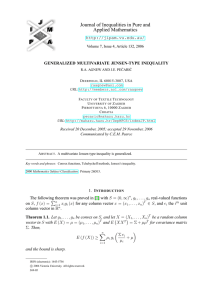
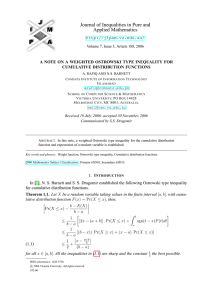

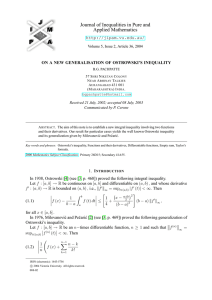

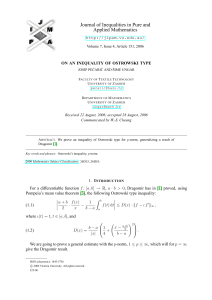

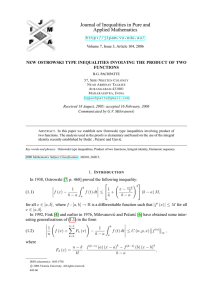
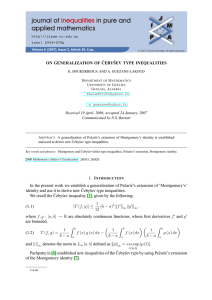
![ON THE WEIGHTED OSTROWSKI INEQUALITY I [5], (1.1)](http://s2.studylib.net/store/data/010717215_1-54ec7398ab903a21d10e53796295a83a-300x300.png)
